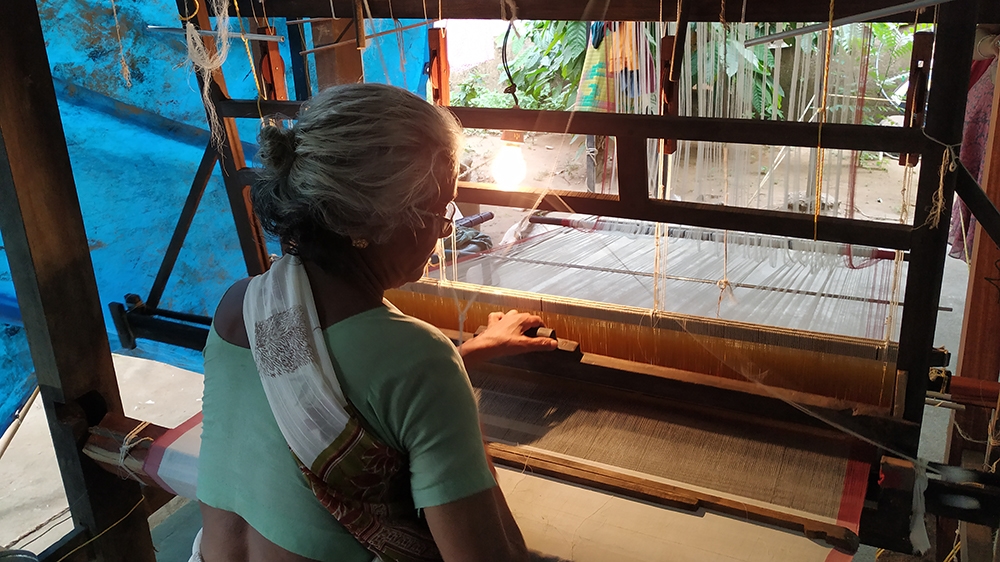Almost six months after floods, Kerala residents wait for help
Kerala, India – Ammini‘s face glows and comes alive whenever she sits at her loom – the 77-year-old’s steady companion for decades.
On August 15 last year, their home in Chendamangalam was hit by waves as high as 11 feet, causing the worst floods since 1924 in the southern Indian state of Kerala.
Nearly 500 people were killed and over a million displaced. The total loss of property was estimated at $3bn.
She says she floated to a nearby relief camp in a large metal vessel pot used to make biryani.
“Four others pushed us forward, swimming through the rising water, which was well over their heads by then. We held on to our lives in that vessel. I thought we would drown,” said Ammini.
Once the waters receded, her family returned home to assess the damage: a dead cow, four broken doors, a collapsed boundary wall, and lots of rotting wood.
Among the debris around their small, three-room house, made of hollow cement bricks and surrounded by fields, lay the bits and pieces of an old investment.
“I bought the loom 50 years ago, when I first started, for what would be 40,000 rupees [$560] today,” said Ammini, who began working at 12.
“I was widowed young when my husband died of cancer. I have always been a weaver.”
 |
| Ammini, 77, works on her repaired handloom [Jithin Shamsu/Al Jazeera] |
Some 700 weavers were severely affected by the floods in Chendamangalam on the outskirts of Kochi city, a well-known handloom hub in India for more than half a century.
The craftspeople in the community are part of an industry that India is struggling to survive. The deadly floods compounded the pressure on an already fledgeling sector.
Looms, equipment, raw materials and finished goods worth nearly $2m were destroyed, says Chendamangalam Handloom Weavers’ Cooperative Society, one of the five weavers’ societies in the area.
Kerala, with millions of its diaspora abroad, mainly in the Gulf, witnessed a massive outpouring of assistance to supplement the government’s compensation.
“Handloom operations resumed after a month and many looms have been replaced. They will be steadily upgraded,” says Sojan PA, the weavers’ society secretary.
“About 90 percent of the damages were covered through local designers and concerned people around the world, who came forward to buy the damaged stock and pay off creditors.”
A number of private initiatives breathed new life into the flood-ravaged weaving sector. But many people fell through the gaps of relief and rehabilitation.
Almost six months later, Ammini’s family, like many others, hasn’t caught up.
In September, a month after the floods, Ammini’s loom was repaired by the weavers’ society. But stress took a toll and she had to undergo an angioplasty.
“I think I fell sick because I was forced to rest for one month. Before the floods, I was always working, so nothing happened. The doctor told me to keep working,” she said.
The elderly weaver, one of around 200 homeworkers under the mandate of the weavers’ society, said health insurance and other benefits have helped.
“But I am weak. I could make two mundus a day when I was healthy, now only one. It is not enough,” said Ammini, who makes a little more than $1 for a mundu, a style of sarong specific to Kerala.
It was like what you see on TV, we were waiting in long lines. The first day there was no food, the second day the rice came, shoes and clothes after two days.
Sujitha, Kerala resident
Meanwhile, her son Balu, 42, has varicose veins which require treatment, while her granddaughter, 10, struggles with psoriasis.
Balu works as a welder for a meagre income of around $12 a day, so his mother-in-law, a nurse in Qatar, sends money home to help. During the floods, Balu was stranded at his submerged home for several days, when a burst vein made him vulnerable to water-borne infections.
“We had five cows. One died in the floods and three had to be sold to finance treatment for my 10-year-old daughter, who has psoriasis. The one remaining will produce milk again only in February,” said Sujitha, Balu’s wife.
“We got around $140 from the government as compensation, but more than that amount went just in cleaning the house,” said Ammini, who claims some of her neighbours – below the poverty level like them – received more government funds.
 |
| Several textile workers in Kerala are still awaiting compensation, almost six months after devastating floods [Jithin Shamsu/Al Jazeera] |
The Employees State Insurance (ESI) Scheme of India said Ammini would have been eligible for medical insurance if she had gone to an ESI hospital. She said she tried with Sojan’s help, but was unsuccessful.
She is grateful for private charity, however.
“The weavers society sent them a benefactor from the Gulf, who gave me and eight others 5,000 rupees ($71) each,” she said.
Sujitha is calm and sturdy next to her frail mother-in-law. She smiles when she remembers the chaos at the relief camp.
“It was like what you see on TV, we were waiting in long lines. The first day there was no food, the second day the rice came, shoes and clothes after two days.”
Last May, Sujitha started a business venture with nine other women with a $14,000 loan. They buy milk and turn it into curd, but that hasn’t yielded much yet.
All of this has meant a reduced income and tremendous strain for the family. The thrill of survival has given way to a lasting sense of insecurity which Sujitha’s and Ammini’s faces betray.
“How will we keep living,” said Sujitha. “How will we go on?”




